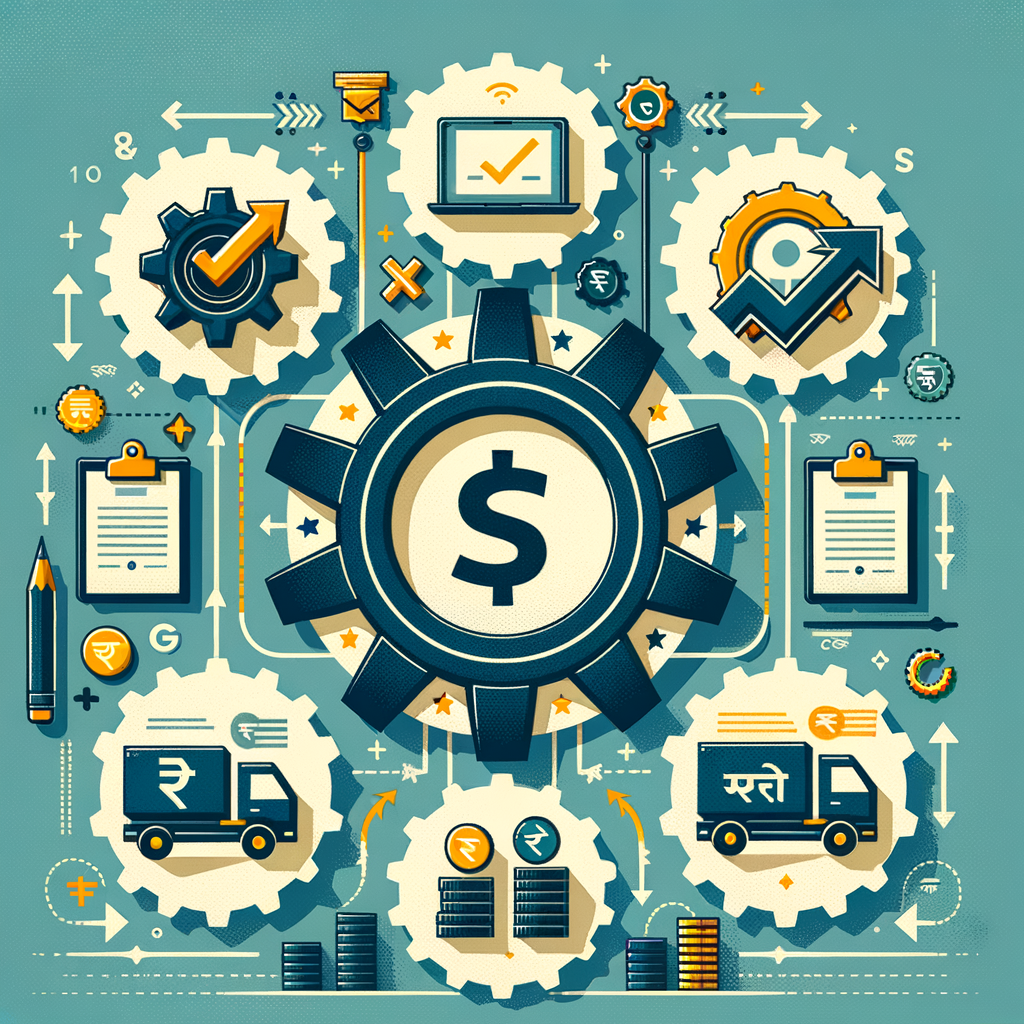The Impact of GST on Supply Chain Management and Invoicing
For any small business owner in India, the days before 2017 often involved navigating a maze of complex taxes. Dealing with VAT, CST, Octroi, and various other state and central levies created logistical nightmares and slowed down business. The introduction of the Goods and Services Tax (GST) was far more than a simple tax reform; it was a fundamental overhaul of India’s economic framework. This article will break down the crucial impact of GST on supply chain management and invoicing for your business. We will explore how the impact of GST on supply chain management India has created opportunities to reduce costs, improve efficiency, and ensure you remain fully compliant in this streamlined tax regime.
Understanding GST’s Core Impact on Business Operations
From Multiple Taxes to ‘One Nation, One Tax’
Before GST, the Indian indirect tax system was fragmented and complex. Businesses had to grapple with a host of taxes levied by both the Central and State governments, including Value Added Tax (VAT), Central Excise Duty, Service Tax, and Central Sales Tax (CST), among others. This multi-layered system created a significant problem known as the “cascading effect,” or tax on tax. Essentially, a business would pay tax on a product and then, at the next stage of the supply chain, the new tax would be calculated on a value that already included the previous tax. This unfairly inflated the final cost for the end consumer and created complex compliance burdens for businesses.
GST was introduced to subsume these multiple taxes into a single, comprehensive, and destination-based tax. By creating a unified market, it aimed to simplify the tax structure, eliminate the cascading effect through a seamless credit system, and make doing business in India easier and more efficient.
Key GST Components: CGST, SGST, and IGST Explained
To manage the tax administration between the Centre and the States, GST is structured into three main components. Understanding them is key to grasping how tax is calculated on your sales.
- CGST (Central Goods and Services Tax): This is the tax collected by the Central Government on an intra-state sale (i.e., a sale happening within the same state).
- SGST (State Goods and Services Tax): This is the tax collected by the State Government on that same intra-state sale.
- IGST (Integrated Goods and Services Tax): This is the tax collected by the Central Government on an inter-state sale (i.e., a sale between two different states).
Let’s look at a practical example for a small business owner based in Mumbai, Maharashtra:
| Transaction Type | Scenario | Applicable GST | How it Works |
|---|---|---|---|
| Intra-State Sale | You sell goods from Mumbai to a buyer in Pune (both in Maharashtra). | CGST + SGST | If the GST rate is 18%, it will be split equally: 9% will go to the Central Government as CGST and 9% will go to the Maharashtra State Government as SGST. |
| Inter-State Sale | You sell goods from Mumbai to a buyer in Delhi. | IGST | The full 18% GST will be levied as IGST, which is collected by the Central Government. The Centre later apportions the state’s share to Delhi (the destination state). |
This new structure, particularly IGST, was the game-changer for logistics across India.
Analyzing the Critical Impact of GST on Supply Chain Management
The single biggest impact of GST on supply chain management has been the radical transformation of logistics and warehousing strategies. GST didn’t just change tax rates; it redrew the map for how goods move across the country.
Consolidation of Warehouses and Strategic Logistics
In the pre-GST era, a company’s warehousing strategy was often dictated by tax laws, not business efficiency. The Central Sales Tax (CST) was levied on the inter-state sale of goods, but this tax was not creditable to the buyer. To avoid this CST cost, companies would set up small warehouses or depots in almost every state where they had a significant customer base. They would first transfer stock to these warehouses (which was not considered a sale) and then sell locally within the state, attracting only the local VAT, which was creditable. This led to a fragmented and inefficient system with high inventory costs, increased administrative overhead, and poor stock management.
The introduction of IGST on inter-state sales, which is fully creditable, made this entire practice redundant. Now, supply chain management under GST regulations India allows businesses to think strategically. Instead of 20 small warehouses, a company can operate with 4 or 5 large, strategically located regional distribution centers. This “hub-and-spoke” model leads to:
- Reduced Capital Investment: Less money is tied up in real estate and infrastructure.
- Lower Operational Costs: Fewer facilities to manage means lower costs for staffing, utilities, and security.
- Better Inventory Management: Centralized inventory control leads to reduced stock-outs, lower carrying costs, and improved forecasting.
- Economies of Scale: Larger warehouses can leverage automation and technology more effectively.
Faster Transportation and Reduced Transit Times
One of the most visible changes post-GST was the disappearance of long queues of trucks at state border check-posts. These check-posts were notorious bottlenecks, where paperwork was manually verified and taxes like Octroi were collected. This process could delay shipments by hours, or even days, leading to higher transportation costs (due to fuel wastage and driver downtime) and unpredictable delivery schedules.
GST unified the country into a single market, eliminating these internal tax barriers. This was further streamlined by the implementation of the E-way Bill system. The E-way bill is an electronic document that must be generated on the official E-Way Bill Portal for the movement of goods exceeding ₹50,000 in value. This digital system allows for the seamless, real-time tracking of goods by tax authorities without the need for physical checks at every border. The result is a significant reduction in transit times, lower logistics costs, and a more predictable and efficient transportation network. For a complete walkthrough, see our Guide to GST E-Way Bill Generation.
Seamless Input Tax Credit (ITC) Across the Chain
Perhaps the most profound benefit of GST is the seamless flow of Input Tax Credit (ITC). In simple terms, ITC means that at every stage of the supply chain, a business can claim a credit for the GST it has already paid on its inputs (raw materials, services, etc.). This credit can then be used to offset the GST liability on its output (the final product or service).
Let’s illustrate:
- A manufacturer pays GST on raw materials.
- When selling the finished product to a wholesaler, the manufacturer collects GST but can deduct the tax already paid on the raw materials.
- The wholesaler, in turn, can claim ITC for the GST paid to the manufacturer.
- This chain continues until the final consumer.
This mechanism ensures that tax is only levied on the “value-added” at each stage, effectively eliminating the cascading tax effect. This is one of the most critical GST implications for supply chain professionals India, as it directly impacts pricing and working capital. By ensuring credit flows smoothly, GST makes the final product cheaper for the consumer and improves the cash flow for every business in the chain. You can learn more about the Section 16 of the CGST Act: Conditions and Time Limits for Availing ITC.
Navigating the GST Effects on Invoicing in India
With a unified tax system comes the need for a unified invoicing system. The GST effects on invoicing in India have been significant, mandating a standardized format that is critical for compliance and the flow of ITC. For an in-depth look, check out our Understanding GST Invoicing: A Detailed Guide.
The Anatomy of a GST-Compliant Invoice
A GST invoice is not just a bill; it’s a foundational document for the entire tax system. An error on your invoice can prevent your customer from claiming their rightful ITC, damaging your business relationship. Therefore, managing invoicing with GST compliance India is non-negotiable.
Every GST-compliant invoice must contain the following mandatory fields:
- Supplier’s Details: Name, address, and Goods and Services Tax Identification Number (GSTIN).
- Recipient’s Details: Name, address, and GSTIN (if registered).
- Invoice Details: A unique, consecutive serial number and the date of issue.
- Goods/Services Details: HSN (Harmonized System of Nomenclature) code for goods or SAC (Services Accounting Code) for services.
- Place of Supply: The state where the goods or services are consumed.
- Taxable Value: The value of the goods/services before tax.
- Tax Breakdown: A clear breakdown of the applicable CGST, SGST, or IGST rates and the corresponding tax amounts.
- Signature: A digital or physical signature of the authorized signatory.
E-invoicing: The Mandatory Digital Shift
Taking standardization a step further, the government introduced e-invoicing. E-invoicing is a system where B2B invoices are authenticated electronically by the GST Network (GSTN) for further use on the common GST portal. Currently, it is mandatory for businesses with an aggregate annual turnover exceeding a specified threshold (this threshold has been progressively lowered, so it’s crucial to stay updated).
The benefits of e-invoicing are substantial:
- Reduces Errors: It standardizes the format and minimizes data entry mistakes that could lead to ITC mismatches.
- Real-time Tracking: Invoices are tracked in real-time by the GSTN, leading to greater transparency.
- Faster ITC Availability: Since the data is pre-validated, it auto-populates in the buyer’s GSTR-2A/2B, allowing for faster and more accurate ITC claims.
- Simplified Filing: Parts of the GSTR-1 return are auto-filled from the e-invoicing data.
Top 3 Invoicing Mistakes to Avoid
Effective GST strategies for effective invoicing India involve being meticulous and avoiding common pitfalls. Here are three mistakes small businesses must steer clear of:
- Incorrect GSTIN: This is the most common and damaging error. If you enter the wrong GSTIN for your buyer, the invoice will not appear in their GSTR-2A/2B, and they will be unable to claim ITC. Always verify the customer’s GSTIN on the GST Portal before issuing an invoice.
- Wrong HSN/SAC Codes: Using an incorrect HSN/SAC code can lead to the application of the wrong tax rate. This can result in either over-charging or under-charging GST, leading to compliance issues, disputes with customers, or notices from the tax department.
- Mismatch in Invoice & GSTR-1 Data: The details you upload in your GSTR-1 return must perfectly match the details on the invoice you issued. Any discrepancy in invoice number, date, value, or tax amount can create reconciliation problems for your buyer and flag your return for scrutiny. Using a good accounting software can help prevent this.
Conclusion
The impact of GST on supply chain management has been nothing short of transformative. It has empowered businesses to move beyond tax-driven logistics towards a model based on pure operational efficiency, enabling warehouse consolidation, faster transit, and reduced costs through a seamless Input Tax Credit system. Similarly, GST has standardized the invoicing process, making it more transparent and digitally driven through mandates like e-invoicing. For small business owners, adapting to these regulations is not merely a compliance task; it is a strategic opportunity to build a more robust, cost-effective, and competitive business for the future.
Navigating GST can be complex. Let TaxRobo’s experts handle your GST registration, filing, and compliance, so you can focus on what you do best—growing your business. Contact us for a free consultation today!
Frequently Asked Questions (FAQs)
1. What is the single biggest impact of GST on a company’s logistics strategy?
The ability to consolidate warehouses. The removal of CST allows businesses to design their supply chain based on logistical efficiency (e.g., proximity to customers) rather than tax laws, leading to significant cost savings in inventory, real estate, and operations.
2. Why is a correct GST invoice so important for my customer?
A correct GST invoice is the primary legal document your customer needs to claim Input Tax Credit (ITC) on their purchase. Any error on your invoice, such as an incorrect GSTIN or tax amount, can cause them to lose this credit, directly impacting their cash flow and potentially damaging your business relationship.
3. What is an E-way bill and when do I need it?
An E-way bill is a digital document required for the movement of goods valued over ₹50,000 between states (and often within a state, depending on state-specific rules). It must be generated from the official portal before the goods are dispatched to ensure compliance and smooth transit.
4. How can small businesses ensure they are creating GST-compliant invoices?
The best way is to use a reliable accounting or invoicing software that is updated with the latest GST rules. These platforms automate the inclusion of mandatory fields, help select the correct HSN/SAC codes, and ensure that the data seamlessly integrates with your GSTR-1 filing, minimizing the risk of manual errors. For more details, you can always refer to the official Central Board of Indirect Taxes and Customs (CBIC) website.



